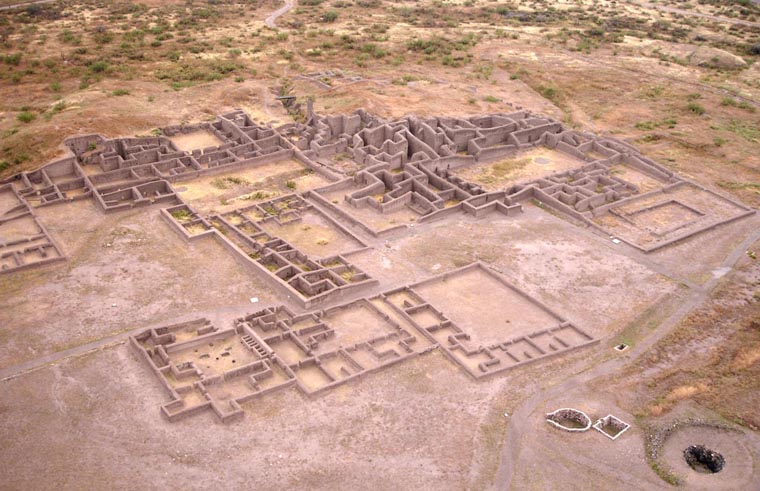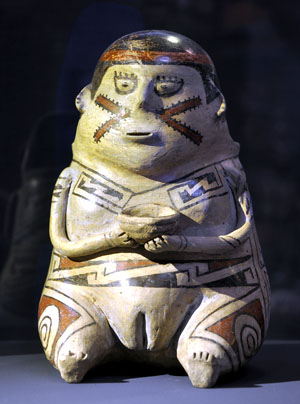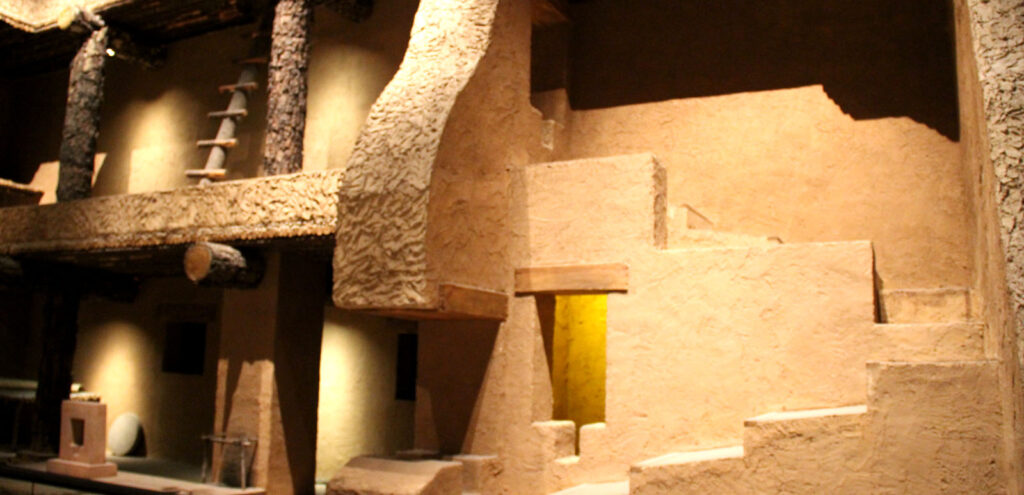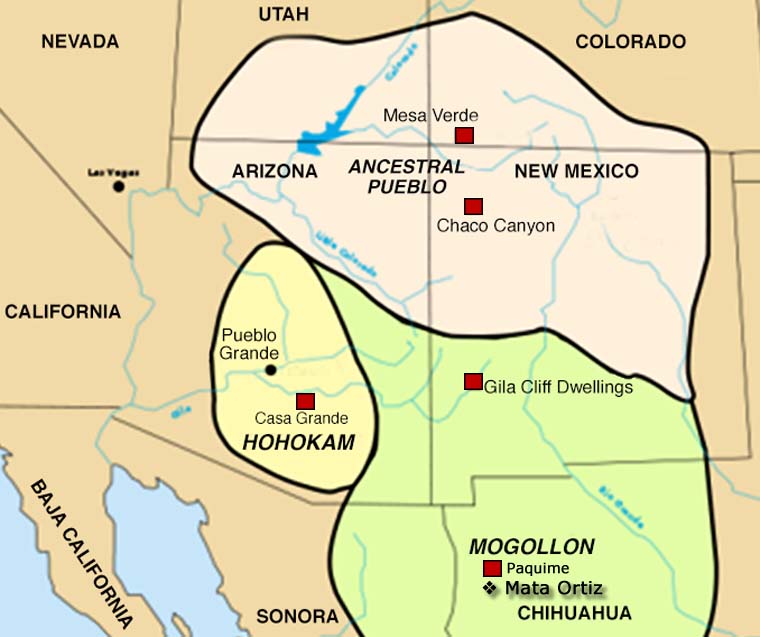About Mata Ortiz and Casas Grandes
Mata Ortiz is a small settlement inside the bounds of the Casas Grandes municipality, very near the site of Paquimé. The fortunes of the town have gone up and down over the years with a real economic slump happening after the local railroad repair yard was relocated to Nuevo Casas Grandes in the early 1960s. It was a village with a past and little future.
A problem around the ancient sites has been the looting of ancient pottery. From the 1950s on, someone could dig up an old pot, clean it up a bit and sell it to an American dealer (and those were everywhere) for more money than they'd make in a month with a regular job. And there's always been a shortage of regular jobs.
Many of the earliest potters in Mata Ortiz began learning to make pots when it started getting harder to find true ancient pots. So their first experiments turned out crude pottery but with a little work, their pots could be "antiqued" enough to pass muster as being ancient. Over a few years each modern potter got better and better until finally, their work could hardly be distinguished from the truly ancient. Then the Mexican Antiquities Act was passed and terror struck: because the old and the new could not be differentiated, potters were having all their property seized and their families put out of their homes because of "antiqued" pottery they made just yesterday. Things had to change almost overnight and several potters destroyed large amounts of their own inventory because it looked "antique." Then they went about rebooting the process and the product in Mata Ortiz.
For more info:
Mata Ortiz pottery at Wikipedia
Mata Ortiz at Wikipedia
Casas Grandes at Wikipedia
About the Prehistoric City of Paquimé

Paquimé was a major center of society, religion, trade and the arts from around 1150 CE to about 1450 CE, when the city was abandoned. When the first Spanish explorer came across the ruins he didn't know what he was looking at as the city was several stories in height and covered a lot of land. But there was no one living there any more.

Archaeologists don't know where the first residents came from but there was a major in-migration to the area in the mid-1100s from the north as the Mimbres Valley was being depopulated and people were moving cross-country. That century of the 1100s was unstable with volcanic ash in the air globally and bad weather event after bad weather event happening.
Paquimé is almost squarely in the center of the Mogollon culture back then, the Mimbres Valley was a northern branch. Paquimé was a crossroads with trade routes carrying turquoise south and birds, copper bells and rituals north.
A lot has been made of the many macaw pens found at Paquimé but little mention of the green parrots. Macaws were trafficked to be used as sacrificial offerings to the sun around the time of the Winter Solstice. We don't know what green parrots were for but their remains have been found in only three places north of the jungles where they normally live: Paquimé, Cicuyé (aka Pecos) and Grasshopper Pueblo (a ruin in east-central Arizona).
Archaeologists following the Turquoise Trail found that many threads of that trail passed through Paquimé headed to different destinations in the south. Returns from the south seem to have been sorted at Paquimé and then sent to their destinations in the north.
Paquimé was a melting pot with inputs coming from the Mayans and the Aztecs meeting inputs from the local area and inputs from the north. When the Mimbres Valley was being depopulated, suddenly their pottery designs were popping up at Paquimé. At Paquimé those ideas and designs were developed further. It helped, too, that multiple colors of clay were easily available around the city: there was an explosion of polychrome pottery and figures.



About Mata Ortiz Pottery
A lot of the story of modern Mata Ortiz is based around the story of Juan Quezada Sr. That story is part marketing fabrication and part reality. His story is similar to that of the Ortiz brothers, working at the same time to get to the same end but working at the other end of the village. There are others (of the Silveira, Ortiz, Olivas, Ledezma and other families) who were hanging around nearby and sometimes getting into the action. All of them had dug and/or had made antiqued pots. They needed to get over that hump and get into the modern market. The full story of Mata Ortiz pottery has to include them all, including Manuel Olivas who was producing antiqued pottery in Nuevo Casas Grandes since the early 1950s. Virtually all of the earliest Mata Ortiz potters connected with Manuel at one time or another, including Juan Quezada.
The marketing story was invented by Spencer MacCallum, an American dealer who stumbled across three of Juan Quezada's pots in a shop in Deming, NM in 1976. He traced them back to Juan and for several years, he had an exclusive contract to represent Juan's pottery everywhere. In furtherance of that project, they put together the story:
Juan was a young farmer who helped the family out by gathering firewood and tending to the family cattle. Everywhere he went in the countryside, he was seeing ancient potsherds in the dirt. They interested him enough that he dedicated more than a decade to discovering and refining the ancient processes for making those pieces of pottery (as whole objects, of course). Most of his process he may have come up with himself but some info he gleaned from Manuel.
Eventually Quezada was successful in his quest. He learned to use sand and other coarse materials for temper. He discovered that dried cow dung made an excellent and inexpensive firing fuel. Instead of using gourds for smoothing he substituted broken hacksaw blades. Instead of using yucca fiber brushes for painting he learned to make brushes with human hair. He persevered in his efforts and by 1971 had produced a kind of polychrome pottery. Since then, most pottery-making in the area has used innovations in the design and decoration of the pots but the materials and the basic crafting of the process have remained the same.
By the mid-1970s, Quezada had attracted a significant number of traders and his work was becoming a commercial success. In his early days touring the US with MacCallum, he was even offering a service to buyers of "old" Paquimé pottery: he would inspect pieces and declare them as truly ancient or just antiqued. That is also when he began teaching his techniques to his immediate family. They in turn taught other family members, friends and the younger generations. Women, men and children were all included from the beginning.
Originally called Casas Grandes pottery in the early years of its production, the potters of this tiny village have made such an impact on the pottery communities, including many awards and special recognition from the Presidents of Mexico, that Mata Ortiz pottery is now known around the world.
Today, pottery production has changed the village in many ways as there is now electricity, plumbing, vehicles and more for the residents. Virtually everyone in the small town (2010 population: 1,182) makes their living by working in some part of the pottery-making process, from potters to clay-gatherers to firewood collectors to traders.
A few years before he passed on in 2007, Manuel Olivas was granted a license from Mexico's National Institute of Anthropology and History that allowed him to legally make reproductions of ancient Ramos Polychrome pieces. When Juan Quezada and Spencer MacCollum were touring the United States to promote Juan's pottery, Juan also examined a lot of "ancient Paquimé pottery" to see if it was real or not. He said about half of what he examined had been made by Manuel pre-1960.
Mata Ortiz pottery incorporates elements of contemporary and prehistoric design and decoration, and each potter or pottery family produces their own distinctive, individualized ware. Young potters from surrounding areas have been attracted to the Mata Ortiz revival and new potting families have developed while the art movement continues to expand. Without the restraints of traditional religious practices or gender constraints, a vibrant flow of new ideas has enabled the pottery of Mata Ortiz to avoid the derivative repetition common to virtually all folk art movements. This blend of economic need, gender equality, cultural expression and artistic freedom has produced a unique artistic movement in today's community.
The pandemic of 2020-2021 severely affected their ability to support themselves as most of their market is in the United States and that market was almost completely closed for a year. Some potters had to find other jobs and some relocated to other parts of the country to support themselves and their families. It was different when the border opened up again.
Our Info Sources
The Many Faces of Mata Ortiz, by Susan Lowell, © 1999, Rio Nuevo Publishers
Secrets of Casas Grandes: Precolumbian Art and Archaeology of Northern Mexico, edited by Melissa S. Powell, © 2006, Museum of New Mexico Press
Mata Ortiz Pottery Today, by Guy Berger, © 2010, Schiffer Publishing Ltd
Mata Ortiz Pottery: Art and Life, by Ron Goebel, © 2008, self-published
The Miracle of Mata Ortiz, by Walter P. Parks, © 1993, The Coulter Press
The Women Potters of Mata Ortiz: Growing Empowerment through Artistic Work, by Kiara Maureen Hughes, © 2009, University of New Mexico, UNM Digital Repository
Most other info is derived from either personal contacts with the potter and/or family members or with individual traders, plus interminable searches of the Internet and cross-examinations of any results returned. If you have any corrections or additional info for us to consider, please send it to: info@andreafisherpottery.com.